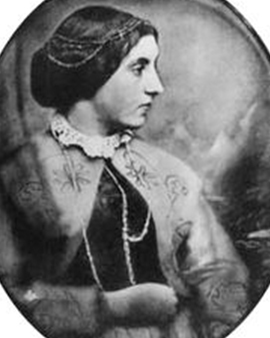


Before the English plant painter Jane Loudon (née Jane Webb) discovered her love of botany, she was a successful writer. After the death of her parents left her on her own at an early age, she initially used her writing talents to make a living. At the age of twenty, she published the fictional novel "The Mummy!" about Egyptian mummies. It is considered a pioneering work of science fiction literature. In it, Loudon described the resurrection of Pharaoh Cheops' mummy in the 22nd century. The resurrected pharaoh travels in a balloon from Egypt to England and interferes in political affairs there. In addition to social advances, technical developments also make life easier in the novel. For example, letters are delivered by cannonballs. In agriculture, a steam-powered plow makes work easier. The novel attracted a great deal of public attention at the time. So did the distinguished author John Claudius Loudon, who was known for his books on agriculture and horticulture.
John Loudon contacted the novelist and was surprised to encounter a woman - she had published under a male pseudonym. Loudon's interest was not limited to the novel. Just seven months after their first meeting, the two married. By her own admission, gardening and botany had been completely foreign to Jane Loudon until then. But she quickly shared her husband's interest and initially supported him in his publications. She found, however, that most of the books on the subject at the time, with their many technical terms, were hardly comprehensible to laymen, and thus at that time especially to women. Loudon learned quickly and soon published her own book on gardening called "Gardening for Ladies." The easy-to-understand, enthusiastically and expertly written work was a great success, selling over 200,000 copies. More books followed, all standard works of Victorian gardening. The books inspired women across the country, and gardening became a major hobby. In addition to acquiring the technical knowledge, Loudon had become a self-taught plant painter and illustrated her books herself.
For her designs, Loudon arranged flowers into bouquets. The popular designs were often copied and adorned trays, tables and lampshades. The Loudons were highly respected and ran in appropriate circles with literary greats such as Charles Dickens. The end of their heyday loomed, however, after a major project of her husband's failed and she lost a position as publisher. In addition, her books were no longer selling due to competing literature. After the death of her much older husband, she had to take care of their daughter alone. She died impoverished at the age of 51. Loudon's works with their botanical illustrations are still highly regarded today. The National Art Library in London houses many of her works.

Before the English plant painter Jane Loudon (née Jane Webb) discovered her love of botany, she was a successful writer. After the death of her parents left her on her own at an early age, she initially used her writing talents to make a living. At the age of twenty, she published the fictional novel "The Mummy!" about Egyptian mummies. It is considered a pioneering work of science fiction literature. In it, Loudon described the resurrection of Pharaoh Cheops' mummy in the 22nd century. The resurrected pharaoh travels in a balloon from Egypt to England and interferes in political affairs there. In addition to social advances, technical developments also make life easier in the novel. For example, letters are delivered by cannonballs. In agriculture, a steam-powered plow makes work easier. The novel attracted a great deal of public attention at the time. So did the distinguished author John Claudius Loudon, who was known for his books on agriculture and horticulture.
John Loudon contacted the novelist and was surprised to encounter a woman - she had published under a male pseudonym. Loudon's interest was not limited to the novel. Just seven months after their first meeting, the two married. By her own admission, gardening and botany had been completely foreign to Jane Loudon until then. But she quickly shared her husband's interest and initially supported him in his publications. She found, however, that most of the books on the subject at the time, with their many technical terms, were hardly comprehensible to laymen, and thus at that time especially to women. Loudon learned quickly and soon published her own book on gardening called "Gardening for Ladies." The easy-to-understand, enthusiastically and expertly written work was a great success, selling over 200,000 copies. More books followed, all standard works of Victorian gardening. The books inspired women across the country, and gardening became a major hobby. In addition to acquiring the technical knowledge, Loudon had become a self-taught plant painter and illustrated her books herself.
For her designs, Loudon arranged flowers into bouquets. The popular designs were often copied and adorned trays, tables and lampshades. The Loudons were highly respected and ran in appropriate circles with literary greats such as Charles Dickens. The end of their heyday loomed, however, after a major project of her husband's failed and she lost a position as publisher. In addition, her books were no longer selling due to competing literature. After the death of her much older husband, she had to take care of their daughter alone. She died impoverished at the age of 51. Loudon's works with their botanical illustrations are still highly regarded today. The National Art Library in London houses many of her works.
Page 1 / 1






